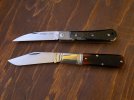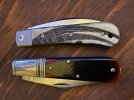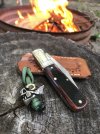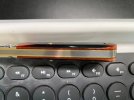-
The BladeForums.com 2024 Traditional Knife is available! Price is $250 ea (shipped within CONUS).
Order here: https://www.bladeforums.com/help/2024-traditional/
You are using an out of date browser. It may not display this or other websites correctly.
You should upgrade or use an alternative browser.
You should upgrade or use an alternative browser.
Blade Forums Spring Street Barlow (BF Knife 2021)
- Thread starter Magizm7
- Start date
khopesh
Gold Member
- Joined
- Jun 23, 2018
- Messages
- 300
How many were made last year?The complaints represent a small percentage of the transactions, IMO!!
I hope someone picks up the ball next year --- with the warning:a big increase in numbers compounds the problems and workload!! 500-plus knives is a far cry from past years!!

- Joined
- Jul 30, 2006
- Messages
- 44,190
Please only discuss this how nice this year's knife is.
This thread is done talking about anything else.
It required a huge effort to calm the waters after this year's mess. I'm not interested in having to make another such effort.
This thread is done talking about anything else.
It required a huge effort to calm the waters after this year's mess. I'm not interested in having to make another such effort.
Pjake
Gold Member
- Joined
- May 2, 2011
- Messages
- 1,530
Received my BF knife....F&F is almost perfect.....but the two pins on mark and pile side by the back springs are very proud. Thinking of taking a Dremel to them. Also bought a stainless in red/black Micarta ..."perfection".
Thoughts? I figure any warranty will fly out the door. Has anyone mulled this issue over? Just curious.
Peter
Thoughts? I figure any warranty will fly out the door. Has anyone mulled this issue over? Just curious.
Peter
JTB_5
Gold Member
- Joined
- Oct 6, 2017
- Messages
- 7,840
Do you have some pictures? It might be better to just use some high grit sandpaper and smooth them a little bit rather than risk taking off too much material with a Dremel.Received my BF knife....F&F is almost perfect.....but the two pins on mark and pile side by the back springs are very proud. Thinking of taking a Dremel to them. Also bought a stainless in red/black Micarta ..."perfection".
Thoughts? I figure any warranty will fly out the door. Has anyone mulled this issue over? Just curious.
Peter
Pjake
Gold Member
- Joined
- May 2, 2011
- Messages
- 1,530
Thanks for the reply...pics would be a bit difficult as I don't have macro lens. The two pins just protrude. If I could get them close to where the stainless is..I'd be happy. It is an incredible knife.....proud pins are just eating at me a bit
May just leave as is...just mulling options.
Peter
May just leave as is...just mulling options.
Peter
khopesh
Gold Member
- Joined
- Jun 23, 2018
- Messages
- 300
- Joined
- May 13, 2019
- Messages
- 8,182
Don't use a dremel, trust me - DON'T.^^^ Thanks!! I'm thinking of doing the same thing. Appreciate it!!
Peter
- Joined
- Mar 26, 2018
- Messages
- 5,453
They just left a little bit of excess material sticking out before they spun the pins in the factory. Without going through the trouble of peening the pins, I can't really think of much you can do about it.
I'm not troubled by it, personally.
I'm not troubled by it, personally.
- Joined
- May 13, 2019
- Messages
- 8,182
Get yourself a locksmith set of files, you can buy them at hobby shops or online, they are not expensive and a handy addition to your tool kit for finicky tasks. Get some 2000 grit sandpaper, dry is okay, but i would use wet/dry. Clamp your blade forums knife securely, place some strips of old tee shirt on the clamp grips in the vice or whatever you use to protect your new knife. Slowly, and i mean slowly file the pins down, then wet and dry sandpaper till smooth. Much safer way of doing it. It is like sharpening, just take your time, and you will be fine.No Dremel?...what would you suggest. Want to do it right!!
Thx,
Peter



- Joined
- Jan 1, 2006
- Messages
- 4,054
I'm honestly wondering if some folks who are suggesting that they'd like to grind their pins down actually have any concept of what a spun pin is. Pins are spun on any knife handle when the maker wants to preserve the surface texture of the handle material while still binding the knife together. That could be anything from stag to jigged bone to textured handles or, in this case, to sawcut bone. There's just a pin sized hole drilled through the covers on these. The pin is inserted and nipped close to the covers, then a concave "bit" is inserted into two opposing chucks, which are spun while they're pressed against both sides of the nipped pin. This spinning pressure and resulting heat form a head on each end of the pin that is drawn against the handles while additionally pulling the assembly together. This head rests on the surface of the handle. In many cases it's not quite totally flat on the bottom but slightly flares down from the pin shaft to the edges, kind of like a mushroom cap. This has been done on sawcut barlows since the advent of spun pins, and you always have some protrusion of the pins, it's just what they do. It's a very strong joint as it should be since there's quite a bit of lateral force on the spring that's trying to pry the knife apart.
Now, if you go and sand that head down even a little you're substantially weakening that joint. You'll be thinning an already soft metal (brass) and the resulting foil thin head (especially near the shaft where it flares up a bit anyway) will eventually start to give resulting in the pin sinking into the hole and causing gaps in the spring/liner/handle. That's if you don't actually wind up filing the whole head off to begin with. There's nothing below that head that's going to hold the parts together.
On knives with smooth handles and flush pins, the entire process is different. The handles themselves are countersunk and the pin is peened into the countersink, filling it and forming a vee head like a wood screw. When the excess pin is sanded off as the handles are sanded, you're left with that vee head below the surface which is what holds everything together the same as that spun pin head does.
You can't achieve the same surface finish results with a spun pin that you get with a countersunk pin, it just won't work and you'll ruin the knife.
Now you're probably asking why the handle pins are flush then. Well they're an entirely different animal. They're pre-headed pins with a half hollow shaft. The hole in the handle is counterbored to fit the pin head, and the liner is countersunk. The pin is pressed from the half hollow end which protrudes from the liner once it's inserted. The press has a wide pointed fixture that spreads that hollow portion of the pin into the countersunk liner, tightly attaching the handle to the liner. That method only works for attaching handles.
I think GEC did a great job on those pins. They're done in such a way that the handles are left totally unmarred by a spinner that got too close which I think is an amazing accomplishment in itself. It'd be a shame to see a bunch ruined for no reason.
Eric
Now, if you go and sand that head down even a little you're substantially weakening that joint. You'll be thinning an already soft metal (brass) and the resulting foil thin head (especially near the shaft where it flares up a bit anyway) will eventually start to give resulting in the pin sinking into the hole and causing gaps in the spring/liner/handle. That's if you don't actually wind up filing the whole head off to begin with. There's nothing below that head that's going to hold the parts together.
On knives with smooth handles and flush pins, the entire process is different. The handles themselves are countersunk and the pin is peened into the countersink, filling it and forming a vee head like a wood screw. When the excess pin is sanded off as the handles are sanded, you're left with that vee head below the surface which is what holds everything together the same as that spun pin head does.
You can't achieve the same surface finish results with a spun pin that you get with a countersunk pin, it just won't work and you'll ruin the knife.
Now you're probably asking why the handle pins are flush then. Well they're an entirely different animal. They're pre-headed pins with a half hollow shaft. The hole in the handle is counterbored to fit the pin head, and the liner is countersunk. The pin is pressed from the half hollow end which protrudes from the liner once it's inserted. The press has a wide pointed fixture that spreads that hollow portion of the pin into the countersunk liner, tightly attaching the handle to the liner. That method only works for attaching handles.
I think GEC did a great job on those pins. They're done in such a way that the handles are left totally unmarred by a spinner that got too close which I think is an amazing accomplishment in itself. It'd be a shame to see a bunch ruined for no reason.
Eric
- Joined
- Sep 13, 2017
- Messages
- 9,113
Just a warning...removing the heads on spun pins like these could result in spring or cover gaps.
Great post, good info.I'm honestly wondering if some folks who are suggesting that they'd like to grind their pins down actually have any concept of what a spun pin is. Pins are spun on any knife handle when the maker wants to preserve the surface texture of the handle material while still binding the knife together. That could be anything from stag to jigged bone to textured handles or, in this case, to sawcut bone. There's just a pin sized hole drilled through the covers on these. The pin is inserted and nipped close to the covers, then a concave "bit" is inserted into two opposing chucks, which are spun while they're pressed against both sides of the nipped pin. This spinning pressure and resulting heat form a head on each end of the pin that is drawn against the handles while additionally pulling the assembly together. This head rests on the surface of the handle. In many cases it's not quite totally flat on the bottom but slightly flares down from the pin shaft to the edges, kind of like a mushroom cap. This has been done on sawcut barlows since the advent of spun pins, and you always have some protrusion of the pins, it's just what they do. It's a very strong joint as it should be since there's quite a bit of lateral force on the spring that's trying to pry the knife apart.
Now, if you go and sand that head down even a little you're substantially weakening that joint. You'll be thinning an already soft metal (brass) and the resulting foil thin head (especially near the shaft where it flares up a bit anyway) will eventually start to give resulting in the pin sinking into the hole and causing gaps in the spring/liner/handle. That's if you don't actually wind up filing the whole head off to begin with. There's nothing below that head that's going to hold the parts together.
On knives with smooth handles and flush pins, the entire process is different. The handles themselves are countersunk and the pin is peened into the countersink, filling it and forming a vee head like a wood screw. When the excess pin is sanded off as the handles are sanded, you're left with that vee head below the surface which is what holds everything together the same as that spun pin head does.
You can't achieve the same surface finish results with a spun pin that you get with a countersunk pin, it just won't work and you'll ruin the knife.
Now you're probably asking why the handle pins are flush then. Well they're an entirely different animal. They're pre-headed pins with a half hollow shaft. The hole in the handle is counterbored to fit the pin head, and the liner is countersunk. The pin is pressed from the half hollow end which protrudes from the liner once it's inserted. The press has a wide pointed fixture that spreads that hollow portion of the pin into the countersunk liner, tightly attaching the handle to the liner. That method only works for attaching handles.
I think GEC did a great job on those pins. They're done in such a way that the handles are left totally unmarred by a spinner that got too close which I think is an amazing accomplishment in itself. It'd be a shame to see a bunch ruined for no reason.
Eric
Murphjd25
Gold Member
- Joined
- Apr 27, 2016
- Messages
- 12,526
Got to agree with the last couple of posts, these pins are done brilliantly. I was only joking when I said they bothered me. I don’t even notice them, and they just exude fine craftsmanship. Unfortunately we live in 2021 now, and that’s the only damn problem 

Johnnythefox
Gold Member
- Joined
- Feb 16, 2017
- Messages
- 4,694
Very,very good advice If it has to be done.Get yourself a locksmith set of files, you can buy them at hobby shops or online, they are not expensive and a handy addition to your tool kit for finicky tasks. Get some 2000 grit sandpaper, dry is okay, but i would use wet/dry. Clamp your blade forums knife securely, place some strips of old tee shirt on the clamp grips in the vice or whatever you use to protect your new knife. Slowly, and i mean slowly file the pins down, then wet and dry sandpaper till smooth. Much safer way of doing it. It is like sharpening, just take your time, and you will be fine.




